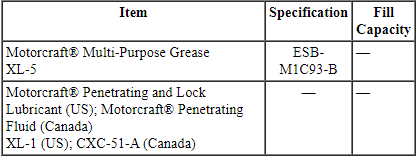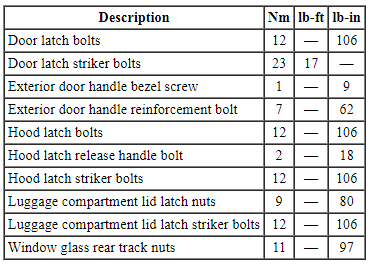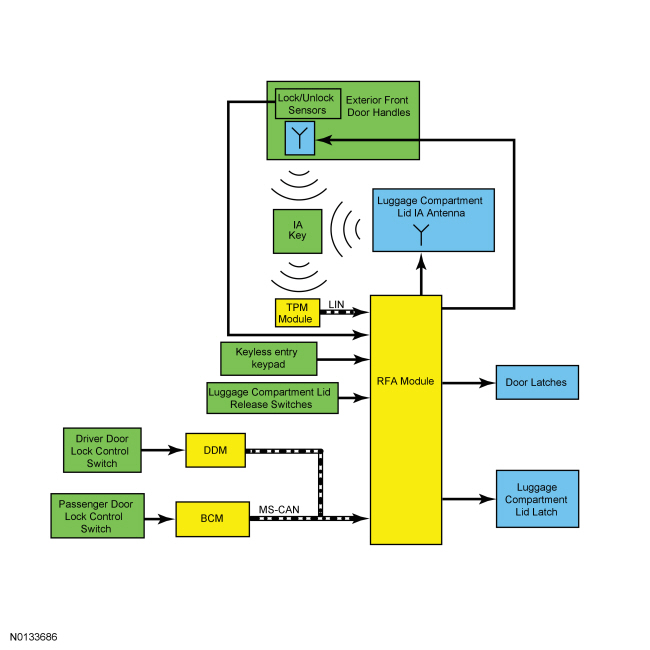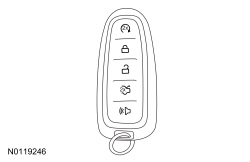SPECIFICATIONS
Material

Torque Specifications

DESCRIPTION AND OPERATION
Handles, Locks, Latches and Entry Systems
Overview
The power lock/unlock feature locks or unlocks the doors upon a customer request from either door lock control switch in the vehicle, a RKE transmitter, or the keyless entry keypad. The power door locking system functions independently of ignition status or vehicle speed.
The IA feature allows locking and unlocking of the vehicle and opening the luggage compartment lid without having to use a conventional key.
System Operation
System Diagram

Network Message Chart
RFA Module Network Input Messages

Power Door Locks
The RFA module controls the door locks by using a series of relays (driver door unlock/passenger doors unlock/all doors lock) integrated within it. When the relays are not energized, ground is provided on both circuits to the lock motors within the latches. When an unlock relay energizes, voltage is provided to one side of the lock motor to unlock the door(s). When the lock relay energizes, the polarity is reversed and the lock motors lock the doors.
NOTE: The door lock and the unlock relays are internal to the RFA module and are non-serviceable.
The DDM sends voltage signals to the left door lock control switch while the BCM sends voltage signals to the right door lock control switch. When a door lock control switch is pressed, the voltage signal is routed to ground, indicating a request to lock or unlock the doors. When the DDM or BCM detect a request to lock or unlock the doors, they send a message to the RFA module over the MS-CAN.
Based upon input from the DDM, the BCM, the RKE transmitter, and the keyless entry keypad, the RFA module energizes the lock all relay, the unlock driver door relay or unlock all relay. When the all lock relay is energized, the RFA module supplies voltage on the all door lock circuit and ground on the driver and passenger door unlock circuits. When the unlock driver door relay or unlock all relay is energized, the voltage and ground are reversed. When the lock and unlock relays are not energized, continuity to ground is supplied on all door lock actuator circuits. A dedicated RFA module ground circuit is provided for the lock and unlock relays.
Luggage Compartment Lid Release
The RFA module sends a voltage signal to the interior luggage compartment lid release switch. When the luggage compartment lid release switch is pressed, the voltage signal is routed to ground, indicating a request to release the luggage compartment lid latch. The RFA module momentarily provides voltage to the luggage compartment lid latch to actuate the release motor.
NOTE: The exterior luggage compartment lid release switch is part of the IA system. For information regarding the luggage compartment lid IA, refer to Intelligent Access (IA) in System Operation.
The RFA module releases luggage compartment lid only when the doors are unlocked electronically or when requested from the RKE system.
Keyless Entry Keypad
The RFA module sends voltage signals on 3 separate circuits to the keyless entry keypad. When an individual keypad button is touched, an individual or combination of the input circuits is routed to ground. Based on these inputs, the RFA module determines which button was touched and locks/unlocks the door(s) or opens the luggage compartment lid.
When a keypad button is touched, the buttons illuminate to provide better visibility. The keypad also illuminates any time the illuminated entry feature is active. If the lock all doors command is entered or 5 seconds have elapsed since the last button press, the keypad illumination turns off.
The keyless entry keypad can be used to:
- unlock the driver door.
- unlock all the doors.
- lock all the doors.
- program/erase the customer key code.
Vehicles equipped with a keypad are programmed with a 5-digit entry code. This code is provided to the customer through a wallet card in the Owner's Literature. In addition, this code is available through a scan tool and is printed on the BCM label. When entering codes, each digit must be entered within 5 seconds of the previous button press.
NOTE: The code displayed on the scan tool is from the RFA module. If it does not match the code on the BCM label, reset the keyless entry keypad code. REFER to Remote Function Actuator (RFA) Module Keyless Entry Keypad Code Reset in Keyless Entry Keypad Code Programming.
Locking the Doors with the Keyless Entry Keypad System
It is not necessary to enter the factory set or personal code prior to locking all doors. To lock all doors, touch and hold the 7/8 and 9/0 buttons at the same time for approximately 2 seconds.
Unlocking the Doors with the Keyless Entry Keypad System
To unlock the driver door, enter either the factory set code or a personal code (each digit must be pressed within 5 seconds of the prior digit). The illuminated entry feature activates unless disabled.
To unlock all doors, enter the factory set code or a personal code (driver door unlocks) and then touch the 3/4 button within 5 seconds. This feature can be changed to a 1-step unlock so that all of the doors unlock when a valid code is entered. REFER to Stepped Unlock Programming.
Anti-Scan Feature
To provide added security, the keypad is disabled for 1 minute after 35 button presses without a valid entry code being entered. The keypad flashes during this 1 minute mode with all functionality disabled except for 7/8 and 9/0 still being allowed to lock the vehicle.
Anti-scan turns off after 1 minute of keypad inactivity, the unlock button is pressed on a RKE transmitter, or the ignition is switched to RUN.
Keyless Entry Keypad Memory Seat Feature
The keypad provides a memory seat, mirror, and adjustable pedal recall feature. The feature is associated with the personal entry codes and positions the driver seat, exterior mirrors, and adjustable pedals to the memory 1 or memory 2. REFER to Keyless Entry Keypad Code Programming and Remote Memory Activation for programming the keypad code to a memory setting.
Factory Keycode Retrieval
The factory keycode for the keyless entry keypad can be retrieved from a label on the BCM, using a diagnostic scan tool, or by using 2 programmed keys.
To retrieve the factory keycode using 2 programmed keys:
- Place the first programmed key into the ignition lock cylinder or backup slot and turn the ignition on.
- Turn the ignition off and remove the first programmed key.
- Place the second programmed key into the ignition lock cylinder or backup slot and turn the ignition on.
The factory keycode displays momentarily in the message center.
Remote Keyless Entry (RKE)
The RKE system uses an IA key. The IA key incorporates both the PATS and the RKE transmitter functions in a single device.
The RKE transmitters can be used to:
- unlock the driver door.
- unlock all doors
- lock all doors.
- open the luggage compartment lid latch.
- arm/disarm the perimeter alarm.
- activate/deactivate the panic alarm.
- provide a visual confirmation when the unlock button is pressed (a long flash of the turn signals).
- provide an audible confirmation when the lock button is pressed twice within 3 seconds with all the doors closed (sounds the horn once).
- provide an audible confirmation when the lock button is pressed twice within 3 seconds and any door is ajar.
- remotely start the engine (if equipped with the factory remote start system).
The RKE transmitters have a normal operating range of 20 m (65.62 ft).
The RKE feature is controlled by the TPM module and the RFA module. When a button is pressed on an IA key, the TIC and RKE command is received by the internal TPM module antenna. If the TPM module determines that it is a valid and programmed TIC, it sends the RKE command and TIC to the RFA module over a LIN circuit. When the RFA module receives the RKE data, it carries out the command by controlling the door locks or sending a message to the BCM to activate the horn and turn signals as required.
The RKE transmitters and the RFA module also utilize a rolling code to prevent the code from being captured by a code grabber. The system advances the counter in the RKE transmitter and the RFA module every time an RKE transmitter button is pressed.
RKE Transmitter Unlock
The RKE feature provides a stepped (if enabled) process for unlocking the doors. Upon receipt of the first request for unlocking the doors, the RKE control feature unlocks only the driver door and provides a long flash of the turn signals. If another unlock request is received within 3 seconds of the first, all the doors are unlocked. This feature can be disabled so that all the doors unlock on the first press of the unlock button. To enable/disable this feature, refer to Stepped Unlock Programming.
RKE Transmitter Lock
The RKE feature requests that all of the doors lock when the lock button is pressed. On any press of the lock button with all doors closed, the doors lock and the turn signals flash once. If the hood, luggage compartment lid or any door is ajar, no flash occurs. As soon as the opening is closed, the turn signals flash.
If 2 presses of the lock button are received within 3 seconds, the horn chirps once and the turn signals flash twice to indicate that the hood, luggage compartment lid and all of the doors are closed and locked. If the hood, luggage compartment lid or any door is ajar when the second lock request is received within 3 seconds of the first, the RKE transmitter feature chirps the horn twice without flashing the turn signals to indicate it locked all of the doors but the hood, luggage compartment lid or a door is ajar. When the ignition is in RUN or START, the turn signal flashes and horn chirp confirmations do not occur.
RKE Transmitter Luggage Compartment Lid Release
The RKE transmitter provides a luggage compartment lid release function. The luggage compartment lid button must be pressed twice within 3 seconds for the luggage compartment lid latch to release.
Panic Alarm
The panic alarm feature provides audible and visual alarms which are evident from the exterior of the vehicle. The panic alarm feature requests that the turn signals flash and the horn sounds until deactivation. The flashing of the outputs occurs simultaneously.
The panic alarm can only be activated when the ignition is OFF. This feature is disabled at all other times. Deactivation of an active panic alarm is accomplished when:
- a second press of the RKE transmitter panic button is detected.
- the ignition is switching out of OFF.
- a period of 2 minutes and 45 seconds elapsing since the initial activation.
Remote Start (If Equipped)
The factory-installed remote start (if equipped), is controlled by a RKE transmitter and allows the engine to start from outside the vehicle. REFER to Section 303-06.
Autolock
The autolock feature locks all of the doors after all of the following have occurred:
- All the doors are closed
- The ignition is in RUN
- The vehicle is shifted into any gear (to put the vehicle in motion)
- The vehicle attains a speed greater than 20 kmh (12.4 mph)
The autolock feature repeats after all of the following have occurred:
- Any door is opened and then closed while the vehicle speed is 15 kmh (9.3 mph) or lower
- The vehicle attains a speed greater than 20 kmh (12.4 mph)
The autolock feature can be enabled/disabled using the message center.
Auto-Unlock
NOTE: The doors do not auto-unlock if the vehicle has been electronically locked before the driver door is opened while the ignition is in OFF or ACC.
The auto-unlock feature unlocks all of the doors after all of the following have occurred:
- The ignition is in RUN, all the doors are closed and the vehicle has been in motion at a speed greater than 20 kmh (12.4 mph)
- The vehicle has come to a stop and the ignition is changed to OFF or ACC
- Within 10 minutes of the ignition changing to OFF or ACC, the driver door is opened
The auto-unlock feature can be enabled/disabled using the message center.
Smart Unlock
The smart unlock feature prevents the doors from electronically locking when an IA key is left inside the vehicle. When a door lock control switch is pressed with one of the doors open and an IA key is detected inside the vehicle, the RFA module commands the doors to unlock and the horn chirps.
To override the smart unlock feature and intentionally lock a key in the vehicle, close all of the doors and lock the vehicle using the keyless entry keypad, press the lock button on another IA key, or lock the doors manually with the lock rod before closing the door.
Intelligent Access (IA)
NOTE: The IA feature is a programmable parameter and can be enabled/disabled with a scan tool. If the feature is disabled, the IA feature to enter the vehicle and passive starting are inoperative. To start the vehicle, the IA key must be placed in the backup transceiver slot.
The IA feature unlocks or locks the doors or releases the luggage compartment lid latch without having to use a mechanical key or the RKE transmitter feature.
When the RFA module detects that a lock or unlock sensor is touched on a front exterior door handle or the exterior luggage compartment lid release button is pressed, it activates the low frequency antenna in the corresponding exterior front door handle or inside the rear bumper cover. The low frequency antenna sends out a signal to the IA key. The low frequency signal activates the IA key and the IA key then sends a high frequency signal back to the TPM module. The TPM module interprets the high frequency signal from the IA key and sends the information to the RFA module. If the RFA module determines that it is a programmed key, the RFA module either unlocks the driver door, unlocks or locks all 4 doors, or releases the luggage compartment lid latch.
Door Intelligent Access (IA)
With a programmed IA key within 1 m (3.28 ft) outside the driver front door, touch the lock or unlock sensor on the exterior door handle. The doors lock or unlock depending upon which sensor was touched on the handle. The unlock button is located on the inside of the handle and the lock button is located on the outside face of the handle.
The driver door IA feature either unlocks the driver door (if stepped unlock is enabled) or all four doors (if stepped unlock is disabled). The IA feature always locks all four doors. REFER to Stepped Unlock Programming for programming information.
The passenger door IA feature always locks or unlocks all four doors.
Luggage Compartment Lid Intelligent Access (IA)
With a programmed IA key within 1 m (3.28 ft) outside the liftgate, press the luggage compartment lid release button on the luggage compartment lid and the luggage compartment lid latch releases.
Component Description
Door Lock Control Switches
The door lock control switches are single pole, double throw switches. They are supplied voltage signals from the DDM (driver door) or the BCM (passenger door) for the lock and unlock requests. When a switch is pressed to lock or unlock, the corresponding input circuit is routed to ground, indicating a request to lock or unlock the doors.
Door Latches
The door latches are sealed units and contain the door lock actuator and the door ajar switch. The door lock actuators operate in 2 directions, depending on the polarity of the voltage. The door latches can be lubricated, if needed. REFER to Latch Lubrication.
Luggage Compartment Lid Release Switches
The luggage compartment lid release switches are momentary contact switches that supply a ground signal to the RFA module. When the luggage compartment lid release switch is pressed, the signal is routed to ground, indicating a request to the RFA module to open the luggage compartment lid.
Luggage Compartment Lid Latch
The luggage compartment lid latch contains the luggage compartment lid release motor and the luggage compartment lid ajar switch. The luggage compartment lid latch release motor is momentarily supplied voltage by the RFA module when a valid request to open the luggage compartment lid is detected.
Keyless Entry Keypad
The keyless entry keypad is a touch sensitive capacitive sensor. When a finger touches the keypad, it changes the capacitance of the sensor in the area of the finger touch. The keypad determines which area is touched and provides a ground signal to the corresponding voltage reference circuit(s). The keypad only works when touched with a finger. The keyless entry keypad may not work when gloves are worn. The gloves act as an insulator and do not allow the finger to change the sensor capacitance.
Intelligent Access (IA) Key

The IA key incorporates both the PATS functions and the RKE transmitter functions in a single device.
During key programming procedures, the PATS and RKE transmitter ID of an IA key are both programmed. Up to a maximum of 4 IA keys can be programmed.
If the IA key battery fails, IA key contains a key blade to unlock the door manually. Additionally, the IA key must be placed in the backup transceiver slot to start the vehicle.
Exterior Front Door Handles
The exterior front door handles contain an IA antenna and a capacitive touch lock and unlock sensors. The antennas and lock/unlock sensors are wired to the RFA module. When activated, the antenna transmits a low frequency signal to activate an IA key.
Luggage Compartment Lid Intelligent Access (IA) Antenna
The liftgate IA antenna is wired to the RFA module. When activated, it transmits a low frequency signal to activate an IA key.
Driver Door Module (DDM)
The DDM sends 2 voltage signals to the driver door lock control switch to monitor the lock/unlock requests. When the switch is pushed to lock or unlock, the corresponding voltage signal is routed to ground pulling the signal low, indicating a request to lock or unlock the doors.
The DDM requires PMI when it is replaced.
Field-Effect Transistor (FET)
The DDM controls the output of several vehicle systems by means of solid state drivers. A DTC sets when an overload occurs on any of these drivers. The module also tracks the number of repetitive faults on each of these circuits, and then it compares that said number of overloads to 3 progressive thresholds established for each circuit. If the third threshold has not been met, the DTC for the affected circuit can be cleared by eliminating the fault, clearing the DTCs and then running a self-test.
At the point that each of the first 2 thresholds is met, DTC B106E sets along with a DTC related to the affected circuit. Once the final (third) threshold has been met, the affected output is permanently disabled, and DTC B106F sets, at which time the DDM must be replaced.
When DTC B1342 is set because the module has reached a third threshold and the DDM has permanently disabled an output, no DTCs can be cleared from the DDM. Using the module self-test to confirm a repair is not possible and a measurement using a digital multimeter of the affected output circuit is required to make sure the fault condition no longer exists.
 Diagnosis and Testing
Diagnosis and Testing
Handles, Locks, Latches and Entry Systems
Special Tool(s)
Material
DTC Charts
Diagnostics in this manual assume a certain skill level and knowledge of
Ford-specific diagnostic practices. Refer to D ...
Other materials:
SecuriCode™ keyless entry keypad
The keypad, located near the driver window, is invisible until you touch
it. It then lights up so you can see and touch the appropriate buttons.
Note: If you enter your entry code too fast on the keypad, the unlock
function may not work. Enter your entry code again more slowly.
You can use t ...
Roadside Emergencies
Vehicles Sold in the United States: Getting Roadside Assistance
To fully assist you should you have a vehicle concern, Ford Motor
Company offers a complimentary Roadside Assistance program.
This program is separate from the New Vehicle Limited Warranty.
• 24 hours a day, seven days a week
...
Safety Belts
PRINCIPLES OF OPERATION
WARNING: Never let a passenger hold a child on his or her lap
while your vehicle is moving. The passenger cannot protect the
child from injury in a crash.
WARNING: It is extremely dangerous to ride in a cargo area,
inside or outside of a vehicle. In a crash, people ridin ...

